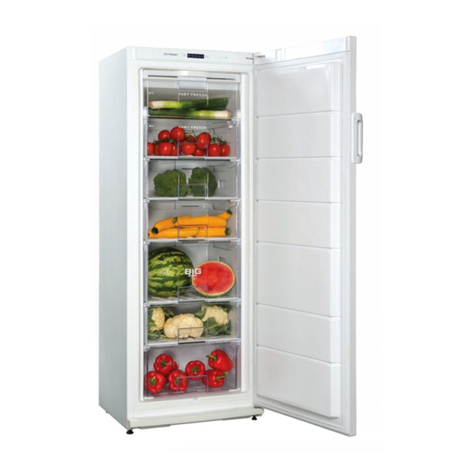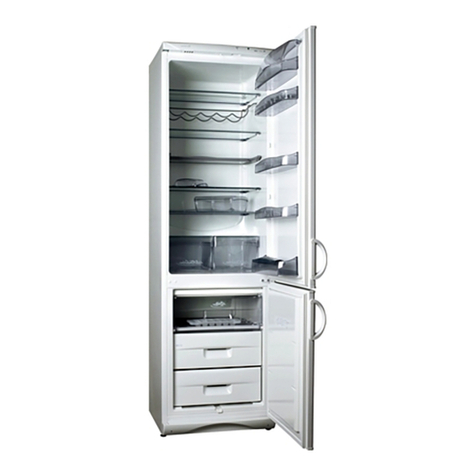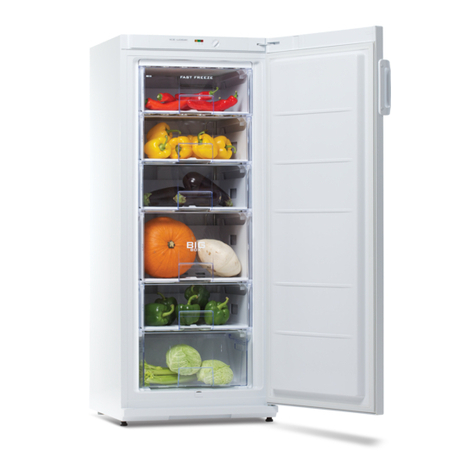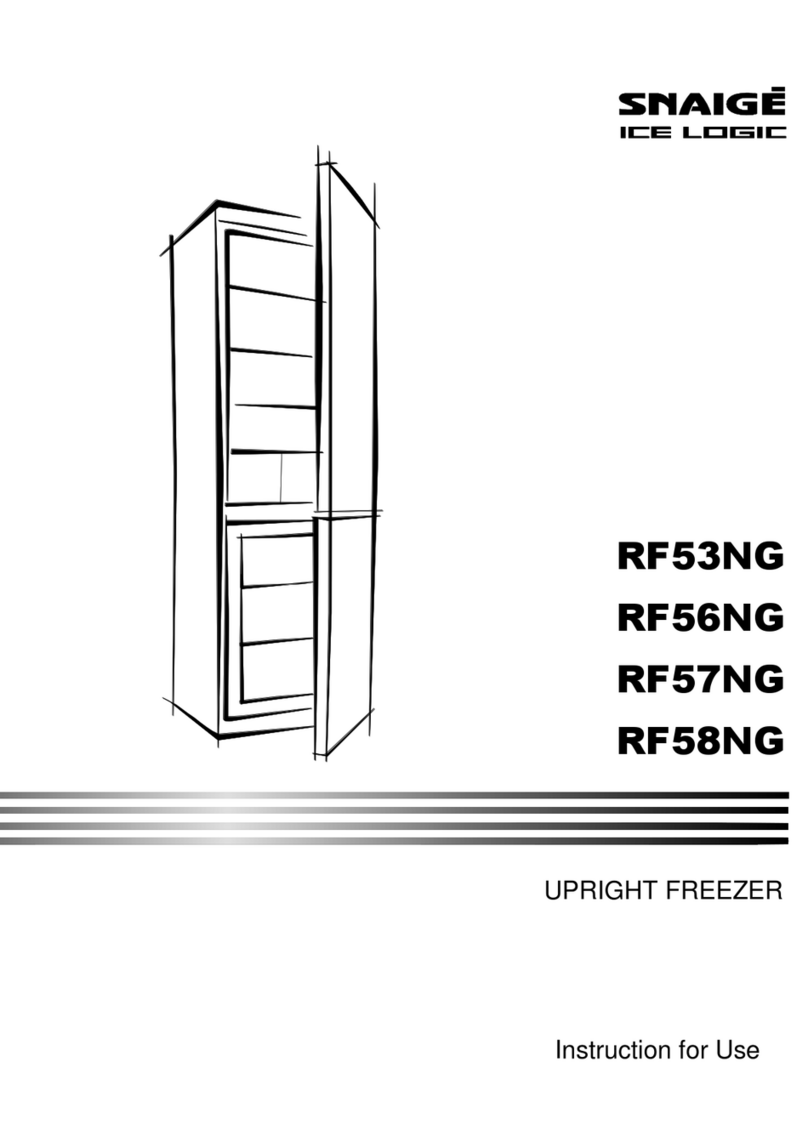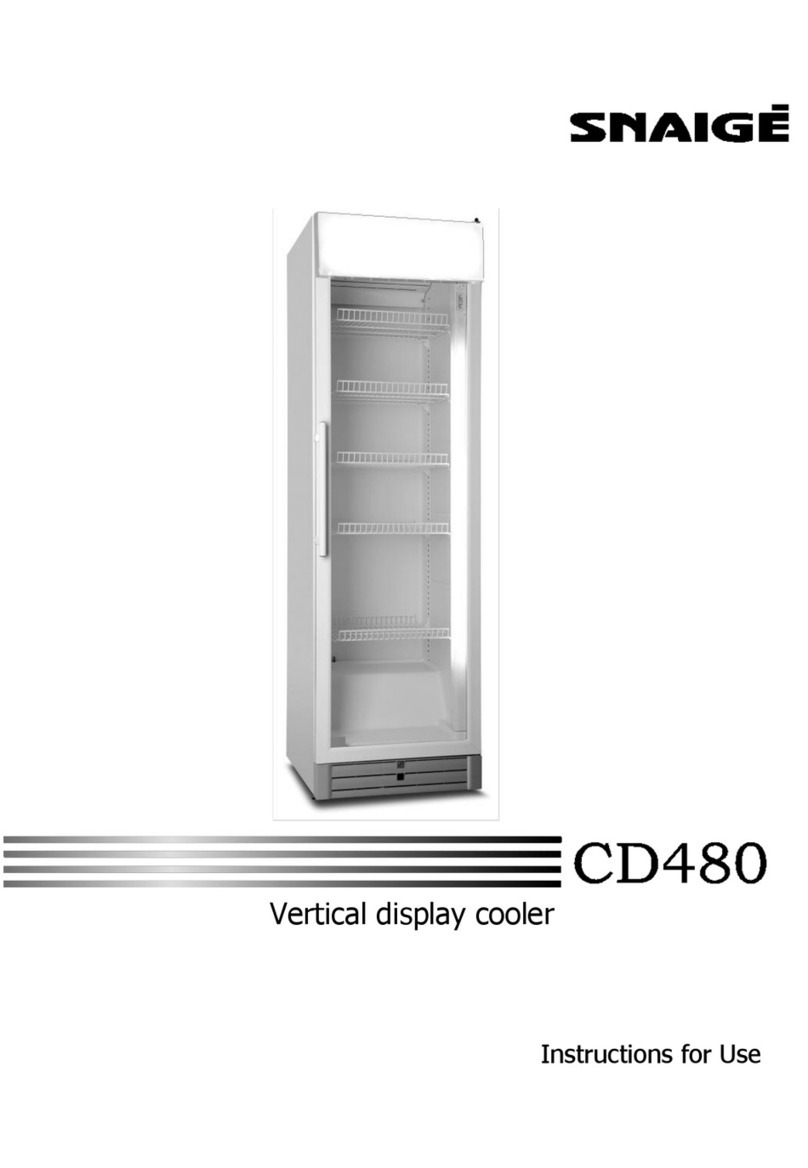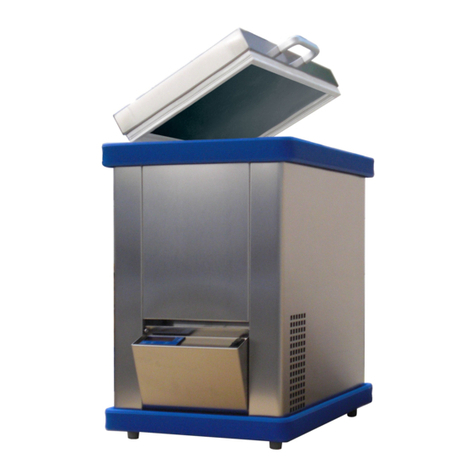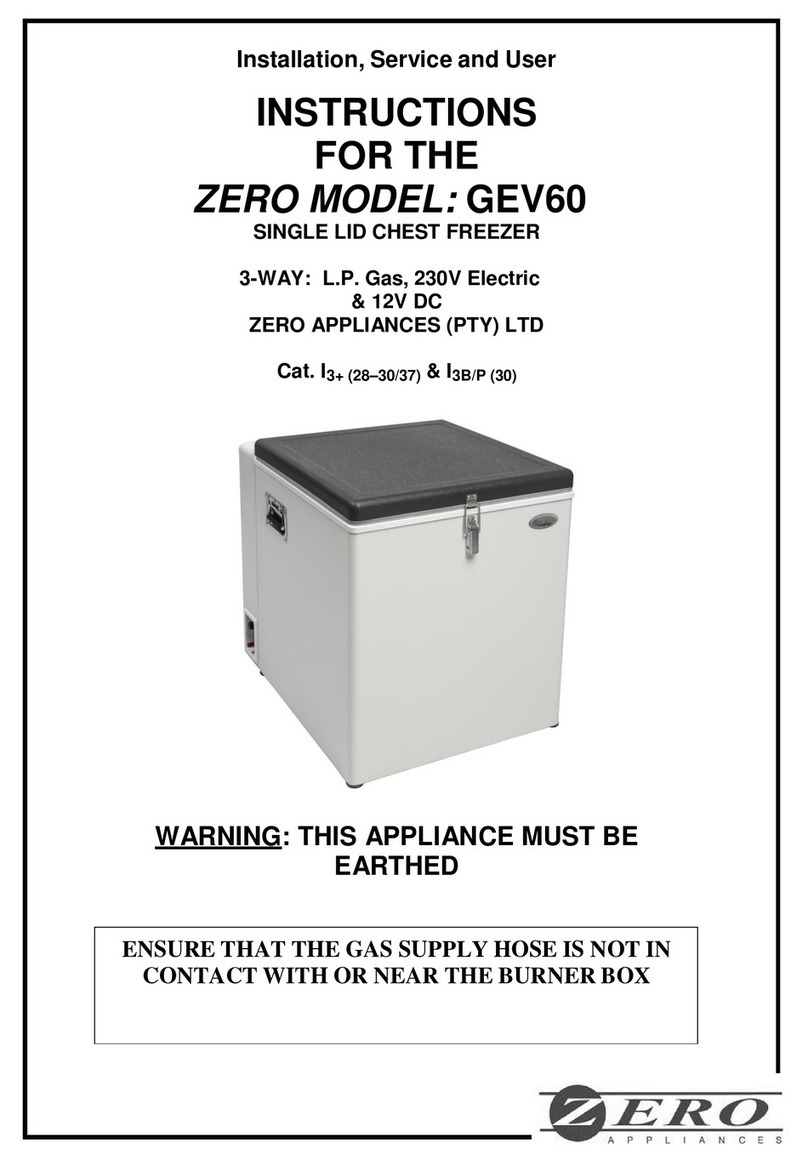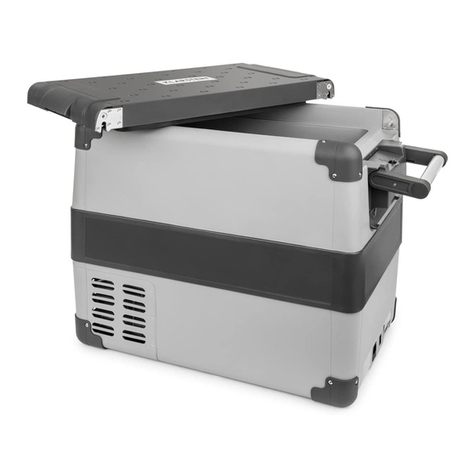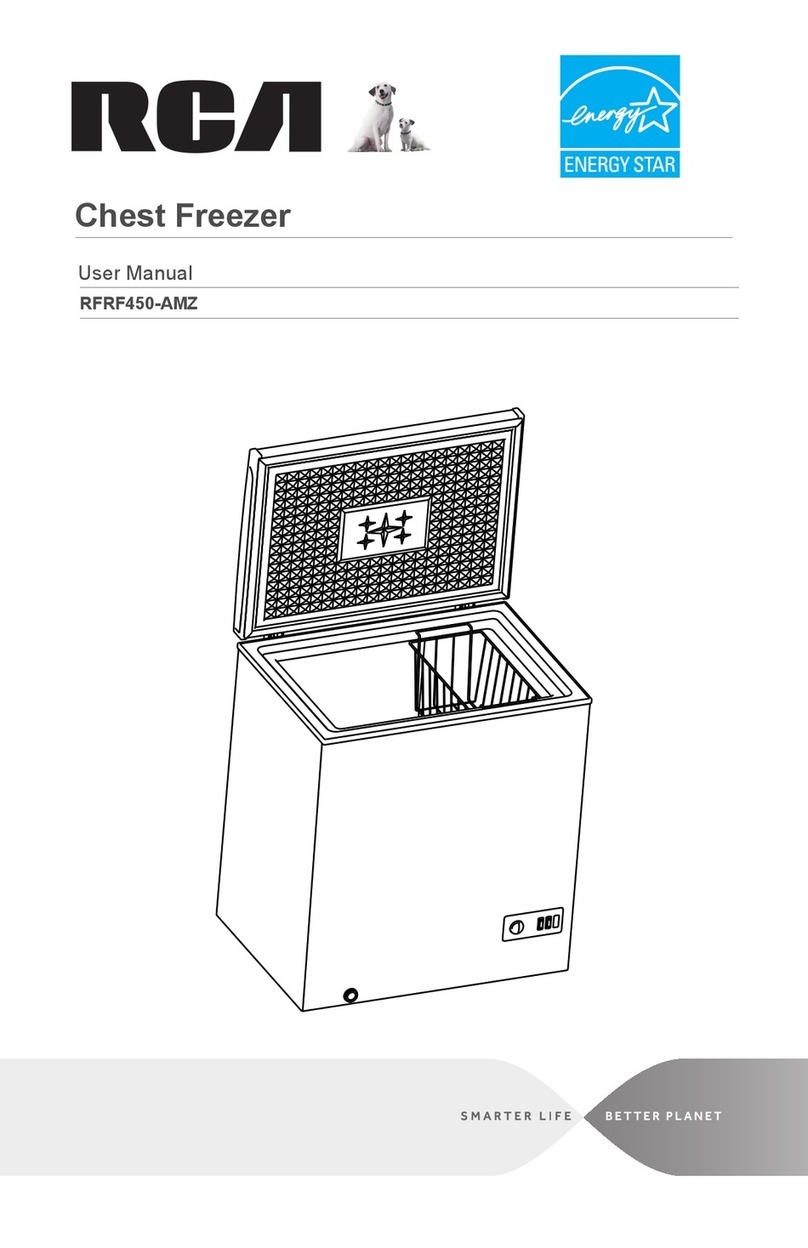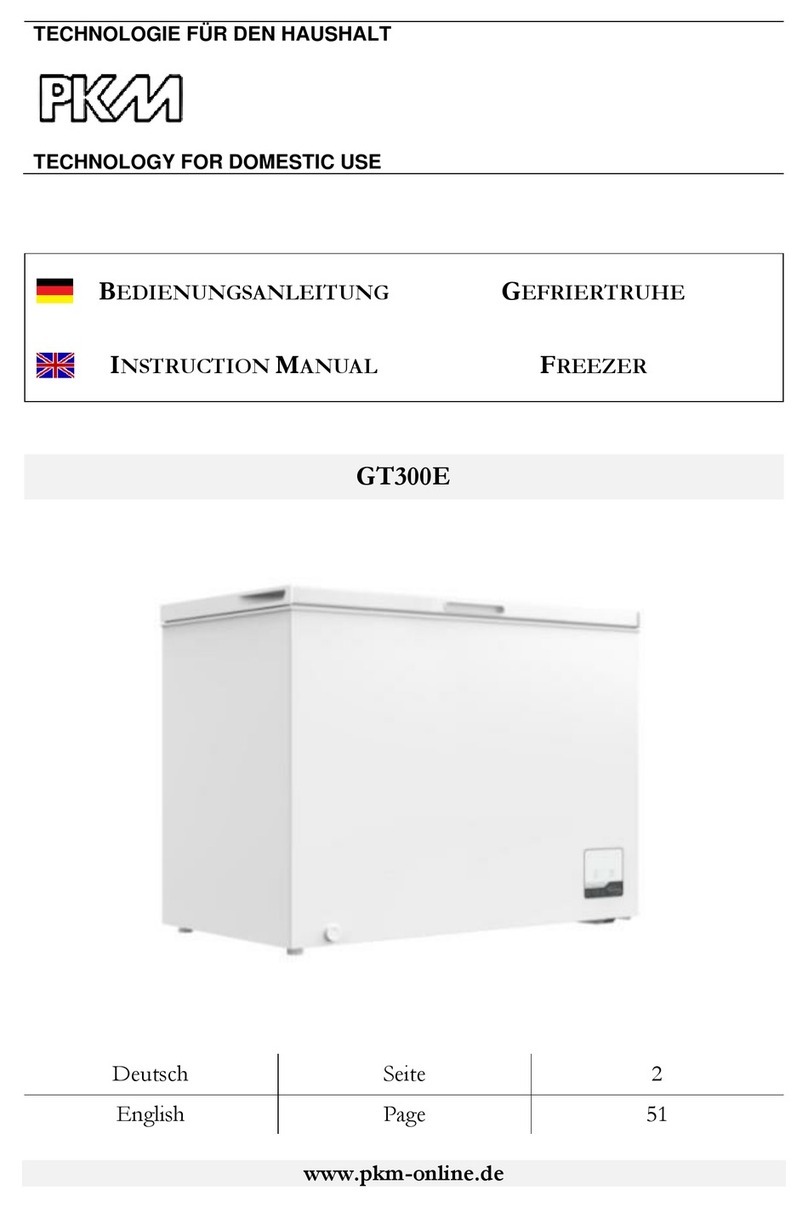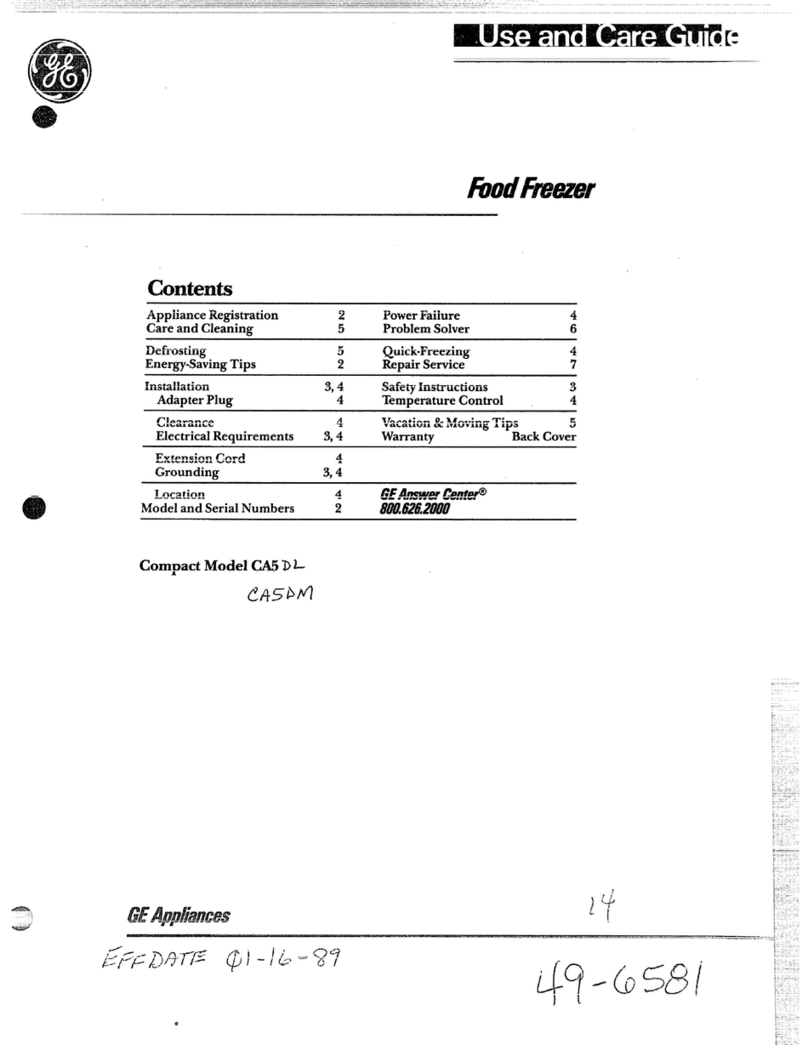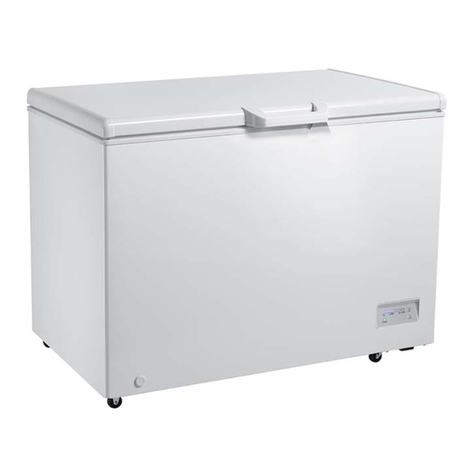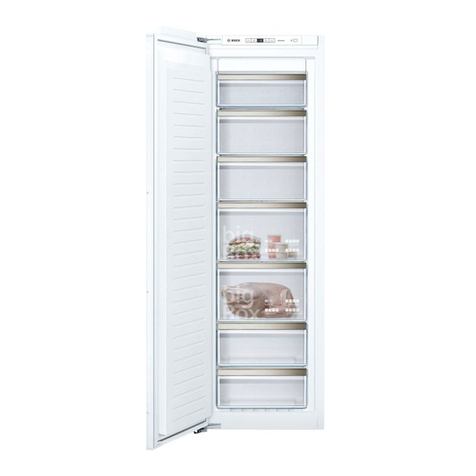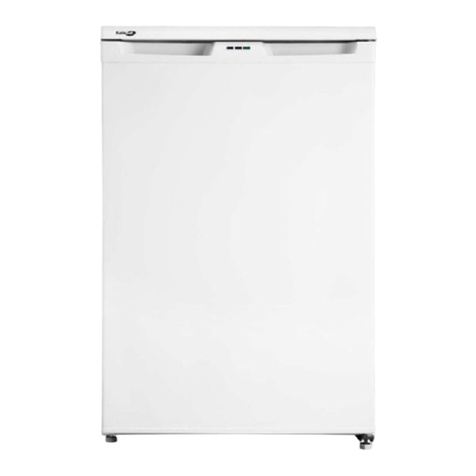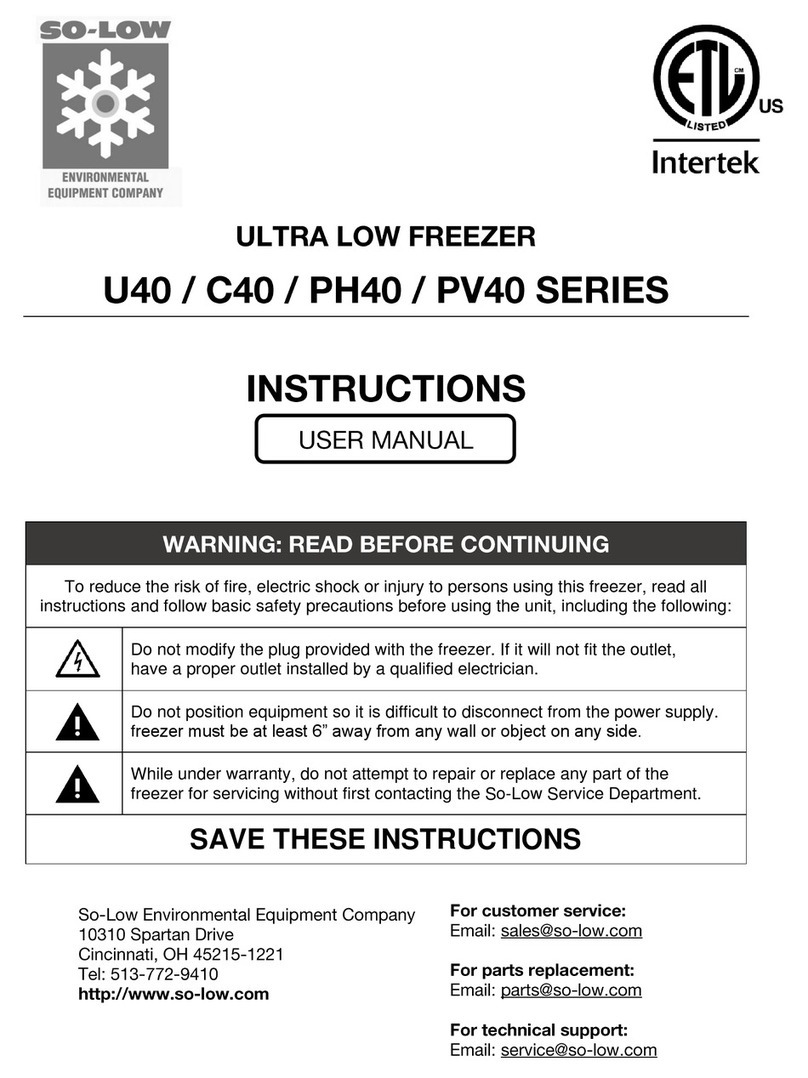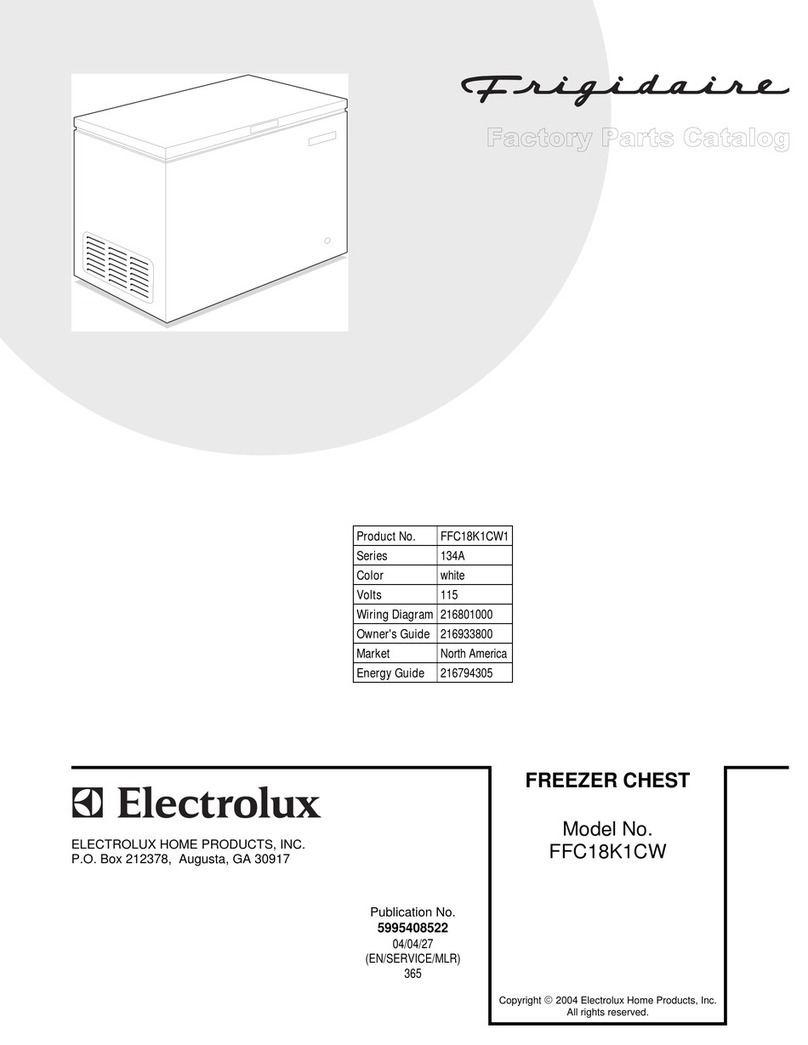SNAIGE F 245 User manual

FREEZER INSTRUCTION MANUAL
GEFRIERSCHRANK BETRIEBSANLEITUNG
DIEPVRIESKAST GEBRUIKSAANWIJZING

1

1

2

3

4
SAFETY INSTRUCTIONS
CAREFULLY READ THE INSTRUCTION MANUAL! If instructions are not followed,
there is a risk of injury, damage of the appliance and loss of the right to free
warranty service. We recommend to keep the Instruction manual the whole time you have
the appliance. When you sell the appliance pass the Instruction manual to the new owner of
the appliance.
WARNING!
–Do not cover the ventilation holes at the top and on the sides of the appliance.
–Do not use any mechanical means or electrical devices to hasten the thawing
process when cleaning the freezer compartment.
–Do not use electrical appliances inside the food storage compartments of the
appliance, unless they are of the type recommended by the manufacturer.
–If the supply cord is damaged it must be replaced by the manufacturer,
manufacturer service agent or a similarly qualified person, in order to avoid a
hazard.
–Disposal of the appliance should be according to national rules.
–Do not damage the appliance refrigeration system. It contains the refrigerant gas
R600a. If the refrigeration system is damaged:
•Do not use any open flame.
•Avoid sparks ―do not turn on any electrical devices or lighting fixtures.
•Immediately ventilate the room.
–Do not allow children to play with the appliance or to plug it in or unplug from the
electricity supply socket. Do not allow children to play with the packaging material
from the appliance.
–The appliance should not be used by children or mentally challenged individuals,
unless they have previously been shown how to operate the appliance by someone
responsible for their safety.
•If the appliance is brought in from the cold (temperature is not higher than +12 °C), you should
wait for two hours before connecting it to the mains.
•The appliance should not be connected to the mains until all packing and transport materials
aren’t removed.
•Once the appliance is unpacked, make sure that it is complete, that the body and the electrical
cord aren’t damaged.
•It is forbidden to use a technically damaged appliance.
CONNECTION TO THE MAINS
–The appliance must be plugged into an earthed electricity supply socket. The
earthed electrical socket by which the appliance is connected to the mains should
be in an accessible place.
–IF THE APPLIANCE IS PRODUCED WITH THE SPECIAL SUPPLY CORD IT CAN BE EXCHANGED
ONLY BY THE SAME SPECIAL SUPPLY CORD PROVIDED BY THE MANUFACTURER.
GB

5
–TO AVOID HAZARDS, DAMAGED POWER SUPPLY CORDS SHOULD BE REPLACED ONLY BY THE
MANUFACTURER, A MAINTENANCE TECHNICIAN, OR A PERSON WITH AN EQUIVALENT
QUALIFICATION.
–DO NOT USE extension cords or connectors (adapters) or couplers.
–The frequency and power of the electricity supply in your house must conform to
the general data parameters of the appliance as it is shown in the product label.
–When positioning the appliance be careful that the electrical cord isn’t squeezed in
order to avoid its damage. Do not store heavy objects such as cooling devices,
furniture or other domestic devices next the appliance in such a way that they could
squeeze and damage the electrical cord. This can cause a short circuit and a fire.
–Make sure that the plug of the electrical cord is not squeezed by the back wall of
the appliance or otherwise damaged. A damaged plug can be the cause of a fire!
•IF THE APPLIANCE IS UNPLUGGED (FOR CLEANING, MOVING TO ANOTHER PLACE, ETC.), IT
MAY BE REPEATEDLY SWITCHED ON AFTER 15 MIN.
•The appliance should be used only for freezing and storing foodstuffs.
•This appliance is not designed for the storage of explosive substances such as aerosol cans with a
flammable propellant.
•It is prohibited to store petrol and other flammable liquids near the appliance.
•The appliance can’t be disposed of by burning.
•Do not place any switched on electrical devices (such as microwave ovens, hair dryers, irons,
electric kettles or other electrical devices) on top of the appliance because this may cause ignition
of plastic parts.
•Do not place any dishes with liquids on top of the appliance and do not keep flowers in vases or
other liquid-filled vessels on the appliance.
•Do not climb on or sit on the appliance, do not lean on or hang on the appliance doors and do
not allow children to do this.
IF THE APPLIANCE IS OUT OF ORDER AND IT IS NOT POSSIBLE TO REPAIR IT BY MEANS
OF GIVEN RECOMMENDATIONS, UNPLUG IT, OPEN THE DOORS AND CALL THE SERVICE
EXPERT. ONLY A SERVICE REPRESENTATIVE CAN REMEDY ALL TECHNICAL OR
CONSTRUCTION FAULTS.
ENVIRONMENTAL PROTECTION INFORMATION
This product is marked in accordance with the European waste regulation 2002 / 96 /
EC -WEEE It regulates the proper disposal of the product. Environmentally friendly
disposal will prevent possible negative consequences to health caused by improper
disposal. This symbol on the product or its packaging indicates that this product must
not be disposed of with the regular household waste. The user has to return the
product to a collection point for the recycling of electric and electronic equipment. The
disposal must comply with the local regulations in place. For further information please contact
your local authorities or waste collection service.
Disable waste equipment before disposal:
• Disconnect the mains plug from the wall socket.
• Disconnect the plug from the mains cable.
• Remove or disable any existing spring or latch locks.
This will prevent children from locking themselves (risk of suffocation!) or from getting into
perilous situations. Children might not understand the risks that arise from handling household
devices. Therefore, observe children and make sure they do not play with the device.

6
GENERAL INFORMATION
The appliance is a upright freezer. The freezer is intended for freezing and long-term storage of
foodstuffs.
THE APPLIANCE IS ECOLOGICALLY CLEAN, CONTAINING NO MATERIALS HARMFUL TO THE
OZONE LAYER: the refrigerant used is R600a, the foaming agent used for the appliance insulation
is cyclopentane C5H10.
THE MANUFACTURER GUARANTEES RELIABLE OPERATION OF THE FREEZER WHEN THE
RELATIVE AIR HUMIDITY NOT GREATER THAN 70 PER CENT AND THE AMBIENT TEMPERATURE
IS:
+16 TO +32 DEGREES CELSIUS (Climate class N);
+16 TO +38 DEGREES CELSIUS (Climate class ST);
+16 TO +43 DEGREES CELSIUS (Climate class T).
Appliance F 245 F 100
Total gross volume, L 243 100
Freezer net volume, L 205 85
Actual consumption will depend on how the appliance is used and where it is
located
Energy efficiency class A+ A+
Energy consumption: kWh / 24 h
kWh / year
0,690
252
0,510
186
Climate class N - ST N - T
Freezer temperature rising time from stora-
ge temperature to -9 ºC after power-cut, h 19 17
Freezing capacity, kg/24 h 12 12
Dimensions (HxWxD), cm 145 x 60 x 63 85 x 56 x 60
Noise level, dB(A) re 1pw 41 38
Electrical Data see in the product label
NOTE. The manufacturer reserves the right to make future changes to technical parameters and
specifications.
DESCRIPTION OF THE APPLIANCE, BASIC PARTS
See page 1, fig. 1
IMPORTANT! THE APPLIANCE ACCESSORIES LISTED BELOW MAY DIFFER FROM THE
ACCESSORIES OF THE APPLIANCE YOU HAVE BOUGHT IN QUANTITY AND IN DESIGN. This
description is adapted for entire group of freezers.
3 Thermostat position indicator 7 Fast-freeze section (s)
4 Electric supply indicator (green light) 8 Frozen products section(s)
5 Thermostat knob- temperature regulator 9 Condenser
6 Temperature rise indicator 10 Compressor

7
REVIEW OF MECHANICAL CONTROL (see page 1, fig. 1)
CONTROL PANEL — DESCRIPTION OF SYMBOLS AND OPERATIONS
3 −THERMOSTAT POSITION INDICATOR marked with the symbol
(marked for model
F 245)
When the appliance door is closed, the thermostat position is seen on the thermostat position
indicator.
4 −ELECTRICITY SUPPLY INDICATOR marked with the symbol
(marked for model F 245)
When the appliance is connected to the electricity supply, the green indicator light is
illuminated. Simultaneously also the the temperature rise indicator lights up. It
indicates that the freezer was switched off for a longer time, i.e. the freezer is switched on
for the first time, after defrosting or after losing of voltage. When the temperature in the
compartment again falls below -9 ºC, the indicator light will go out.
6 −THE TEMPERATURE RISE INDICATOR marked with the symbol
(marked for model
F 245).
When the temperature in the freezer compartment rises above -9 ºC, the red indicator
light is illuminated. It indicates that:
•The freezer was switched off for a longer time, i.e. the freezer is switched on for the first
time, after defrosting or after losing of voltage.
•The door of the freezer is opened or is being opened too frequently.
•It is loaded a large amount of unfrozen foodstuffs.
•The freezing system is failed, i.e. the indicator does not go out longer 6 hours and
it is heard running compressor or the compressor does not switch on. In this case
you should apply to your service agent (at first make sure that three above items
were taken into account).
PREPARING THE APPLIANCE FOR OPERATION
It is recommended to prepare the appliance for operation with a helper.
•Remove package. Lift the appliance away from foamed polystyrene base.
If your freezer is fit with screwed handles. Do not rise or push it taking by
handles. Handles may break.
•Tear off adhesive tapes.
•When positioning the appliance in chosen location, it will move more
easily into position if you lift the front a little and incline it backward,
allowing it to roll on its casters.
•Remove the support from the bottom cover (fig. 2). Tear away the
adhesive tapes from the door trays – they are intended only for the
transport of the appliance.
•Suitably dispose the packaging
material.
•Take two supports from the bag and insert them into the guides
at the top back part of the appliance (fig. 3).
ATTENTION!
In order to fix the upper small door when closing,
the upper corners of the door till a click (see page 1, fig. 1).

8
POSITIONING
•Place the appliance in a dry, well ventilated room.
WARNING! The appliance should not be operated in an unheated room or porch.
Place the appliance away from heat sources such as kitchen stove/oven, radiators, or
direct sunlight.
WARNING! The appliance must not touch any pipes for heating,
gas or water supply or any other electrical devices.
•Do not cover the ventilation holes at the top of the
appliances–it must be a good air circulation around the
appliance. There should be a gap of at least 10 cm
between the top of the appliance body and any furniture
that may be above it. (see fig. 4). If this requirement is
not followed, the appliance consumes more electrical
energy and its compressor may overheat. X
•The appliance must stand on a level surface and must
not touch the wall.
If necessary,
regulate the height
of the appliance by
adjusting the
levelling feet: by turning them clockwise – the front of the
appliance rises, by turning them counter clockwise – it
comes down. If the appliance is tilted slightly backward –
the doors will close by themselves.
•WIf the appliance is placed in a corner, a gap of at least 6
cm must be left between the appliance body and the wall so
that the freezer door can be opened enough to pull out the
frozen product drawer (see fig. 5).
TEMPERATURE REGULATION
Temperature set in the freezer by the manufacturer is -18 0C.
For model F 245
The temperature in the appliance is controlled using the thermostat knob 5(fig. 1) by turning it to
one side or the other. The temperature indication in digits is shown beside the thermostat knob.
When the appliance door is closed, the thermostat position is seen on the thermostat position
indicator 3 (see page 1, fig. 1). The temperature is regulated on the scale of five digits.
0= Compressor is switched off. WARNING! Electric current is not switched off.
1= highest temperature (lowest cooling)
5= lowest temperature (highest cooling)
For model F 100
The temperature in the appliance is controlled using the thermostat knob 5(see page 1, fig.
1) by turning it to one side or the other. The temperature indication in digits is shown beside
the thermostat knob (fig. 1). The temperature is regulated on the scale of five digits.
= Compressor is switched off. WARNING! Electric current is not switched off.

9
1= highest temperature (lowest cooling)
4= lowest temperature (highest cooling)
Please set the desired temperature in the appliance according to your own requirements!
THE TEMPERATURE IN THE REFRIGERATOR COMPARTMENT MAY VARY DEPENDING ON
AMBIENT TEMPERATURE, THE AMOUNT OF FOODSTUFFS, THE TEMPERATURE OF THE
FOODSTUFFS, AND HOW OFTEN THE APPLIANCE DOOR IS OPENED AND CLOSED.
Therefore we recommend:
•locate the appliance away from heat sources,
•food placed in the appliance should not be warmer than the room temperature,
•appliance door must not to be left open,
•the appliance door should not be open longer than it is necessary to take out or put in foodstuffs.
IF THE ROOM IS COOL, THE APPLIANCE COOLS LESS. THE TEMPERATURE IN THE
APPLIANCE MAY THEREFORE RISE. Use the thermostat wheel to set a lower temperature.
FREEZING OF FOOD STUFFS IN THE FREEZER COMPARTMENT
In the freezer compartment, the fast-freeze section is marked with the symbol
Place the fresh food products to be frozen in one or two rows in the fast-freeze section. When the
food products are frozen should be removed from the fast-freeze section and placed in the storage
section drawer(s) (fig. 1).
DO NOT EXCEED THE INDICATED MAXIMUM AMOUNT OF FOOD FOR FREEZING
(see page 6).
•Leave a gap of not less than 2,5 cm between the foodstuffs being frozen
and the upper partition (see fig.).f
•Do not place unwrapped foodstuffs in the freezer sections.
•Fresh food for freezing should not touch already frozen foodstuffs.
•Do not freeze foodstuffs that are warmer than the room temperature.
•Do not freeze liquid foodstuffs in glass vessels or bottles. Do not
freeze carbonated beverages.
•Strictly observe the frozen foodstuffs validity dates indicated by the manufacturer on the their
packaging.
•WE RECOMMEND THAT FROZEN FISH AND SAUSAGE SHOULD BE STORED IN THE FREEZER
COMPARTMENT NOT LONGER THAN 6 MONTHS; CHEESE, POULTRY, PORK, LAMB – NOT MORE
THAN 8 MONTHS; BEEF, FRUIT AND VEGETABLES – NOT LONGER THAN 12 MONTHS.
MAKING ICE-CUBES
Ice-cubes are prepared in a tray for making ice-cubes. Fill each space in the ice cube tray ¾ full of
drinking water. Place the ice-cube tray in the fast-freeze section. When you want to remove the
ice-cubes from the ice-cube tray, leave it for 5 min at room temperature and then shake the cubes
into the special dish for them.

10
DEFROSTING THE FREEZER COMPARTMENT
The freezer compartment should be thawed not less than twice a year or when a layer of ice
thicker than 5 mm forms in it. Do the actions below in the order they are listed:
WA R N ING! Turn the appliance off and pull the plug out of the
electrical socket.
•To remove foodstuffs, to place them into containers, to cover them with
a heavy cloth and to leave them in a cold place.
•For model F 245. To pull out the plug on the bottom of the freezer.
The plug will be pulled out easier after 10 - 20 minutes.
•For model F 100. Place a dish under the thaw water channel.
•To leave the door of the compartment open.
•When the ice melts, clean and wipe dry the surfaces and fixtures of the
freezer compartment.
•Close the freezer compartment door. Plug in and turn on the appliance.
CLEANING AND CARE
REGULARLY CLEAN THE APPLIANCE.
Remember that before defrosting the freezer compartment and cleaning the
back part of the appliance body you must disconnect the appliance from the
electrical energy supply socket by pulling the plug out of the electricity outlet.
•Protect the appliance inner surfaces and plastic parts from fats, acids and sauces. In case of
accidental spills – immediately clean with warm soapy water or dishwashing detergent. Wipe dry.
•Clean the appliance inner surfaces with warm soapy water. Dishwashing detergent may also be used.
•Wipe dry inner and outer surfaces.
•Regularly clean the hermetic gaskets of the doors. Wipe dry.
•At least once a year clean dust away from the back part of the appliance
body and the compressor. A soft brush, electrostatic cloth or vacuum
cleaner may be used for cleaning (see fig.).f
•DO NOT use detergents containing abrasive particles, acid, alcohol or
benzene for cleaning the appliance inner and outer surfaces.
•DO NOT use for cleaning cloths or sponges that have coarse surfaces intended for scrubbing.
PRACTICAL TIPS AND OBSERVATIONS
•Do not consume ice made in the freezer straight away.
•Products will freeze more quickly if they are divided up and packed in small portions.
•IF THE APPLIANCE IS TO BE LEFT SWITCHED OFF FOR AN EXTENDED
PERIOD, LEAVE ITS DOORS OPEN.
Remarks on the appliance operating noise. As the appliance operates and
goes through the freezing cycle, various noises will be emitted. This is normal and is not a
sign of any malfunction.
•As the refrigerant circulates around the refrigeration system, it causes sounds like murmuring,
bubbling or rustling.
•Louder sounds like popping or clicking may be heard for a short time as the freezer compressor
switches on.

11
CHANGING THE OPENING DIRECTION OF THE DOORS
It is recommended that changing the opening direction of the doors should be done with a helper.
You will need two spanners No. 8 and No. 10 and a Philips head screwdriver.
When changing the opening direction of the doors, YOU CAN NOT lay the refrigerator horizontally.
Do the actions below in the order they are listed:
WARNIN G! Turn off the refrigerator and pull the plug out of the electricity supply
outlet.
For model F 245 see page 2, fig. 6
1. Remove bottom bracket 1. Remove bottom bracket 2together with the washers on the axle
and the plastic spacer. Remove compartment door.
2. Remove cap 4from the refrigerator door and press it in on the opposite side.
3. Unscrew axle 5by turning it counter-clockwise. Remove it together with the bolt and washers.
4. On the opposite side, screw in axle 5in a clockwise direction together with the bolt and
washers.
5. Turn bracket 2, together with the nuts on the axle and the plastic spacer, around a full 180°,
replacing the nuts on the axle and tightening them on the opposite side.
6. Screw bottom bracket 4together with the washers on the axle and the plastic spacer into the
place for bracket 2. Screw bracket 2into the place for bracket 4. Remove bolt caps (a) and
plugs (b). Unscrew the bolts holding the handles in place. Move the handles to the other side.
Screw on. Press plugs into the remaining apertures in the door and cover bolts with caps a.
7. Replace bottom lid 1.
For model F100 see page 3, fig. 7
1. Remove support 1and undo screws 2.
2. Undo the two screws 3that hold the pull-out shelf.
3. Remove pull-out shelf 4.
4. Take off bracket 5together with the washers that are on the axle.
5. Unscrew the axle from bracket 5together with its washers and screw it into the second
aperture of bracket 5.
6. Remove compartment door.
7. Remove plug 7from refrigerator door and press it in on the opposite side.
8. Take off bottom bracket 8together with the washers that are on the axle. Unscrew the axle by
turning it counter-clockwise. Turn bracket 6around a full 180° and screw the axle back in. Fix
the bracket in place on the opposite side.
9. Mount refrigerator compartment door on the axle of bracket 8.
10. Fix bracket 5 in place together with the washers that are on the axle.
11. Put the pull-out shelf back in place and replace screws 2and 3. Place support 1in the groove
at the top back part of the refrigerator.
12. Remove bolt caps aand plugs b. Unscrew the bolts holding the handles in place. Move the
handles to the other side. Screw on. Press plugs into the remaining apertures in the door and
cover bolts with caps a.

12
OPERATION PROBLEMS AND THEIR SOLUTIONS (TROUBLESHOOTING)
What if …
•The appliance is plugged in to the mains but it does not work and the electricity supply
voltage indicator is not illuminated. Check that your house electricity supply installations are in
order. Check that the plug is correctly inserted into the electricity supply socket.
•The noise has become louder. Check that the appliance is standing stable on a level place. To
make it level, regulate the front feet. Check if the appliance is not touching any furniture and that
no part of the refrigeration system at the back part of the appliance body is touching the wall.
Pull the appliance away from any furniture or walls. Check that the cause of increased noise isn’t
due to bottles, cans or dishes in the appliance that might be touching each other.
•When the appliance door is opened, the rubber sealing gasket pulls out. The gasket is
smeared with sticky foodstuffs (fat, syrup). Clean the sealing gasket and the groove for it with
warm water containing soap or dishwashing detergent and wipe dry. Put the rubber sealing
gasket back into the place.
•The temperature rise indicator light is illuminated red. This means the appliance is being
connected to the electricity supply for the first time or it was disconnected for a significant period
(for thawing or during an interruption to the electricity supply), the freezer door is not closed or
is being frequently opened and closed, or a large amount of fresh food has been put in, and
therefore the temperature in the compartment has risen above -9 ºC. When the temperature in
the compartment again falls below -9 ºC, the indicator light will go out.
ATTENTION! If the temperature indicator light does not go out (for reasons other
than those listed above) for longer than six hours, the compressor is either working
constantly or is not functioning. You need to consult service people.
•High temperature in appliance, the compressor operation pauses are short. Ascertain
whether the appliance door are shutting tightly, whether the door wasn’t kept open longer than
necessary when taking out or putting in foodstuffs or whether a large amount of warm food was
placed in the appliance.
•The top of the appliance has condensation on it. The ambient relative air humidity is
above 70 %. Ventilate the room where the appliance stands and if possible remove the cause
of the humidity.
TRANSPORT
THE MANUFACTURER WILL NOT BE RESPONSIBLE FOR ANY DAMAGE OF THE APPLIANCE
THAT RESULTS FROM NON-COMPLIANCE WITH THE INSTRUCTIONS FOR
TRANSPORTATION.
•The appliance should be transported in the vertical position.
•When being transported, the appliance should be protected from atmospheric conditions (rain,
snow, dampness).
•The appliance should be firmly secured in place while being transported, to avoid slippage or any
shocks in the transport vehicle.
•If the appliance was transported not vertically, it may be connected to the mains after 4 hours at
least. If this is not done, the appliance compressor may fail.
WARRANTY SERVICE
IF YOUR APPLIANCE IS NOT WORKING PROPERLY, ASCERTAIN WHETHER YOU CAN REMEDY THE
CAUSE OF THE FAULTY FUNCTIONING OF THE APPLIANCE
YOURSELF. If you cannot solve the problem yourself,
contact the nearest refrigerator service representative by
telephone or in writing. When making contact necessarily
indicate the refrigerator model 1and number 2. You will
find this data on the product label, which is glued to the
wall of the freezer compartment.

13
SICHERHEITSHINWEISE
LESEN SIE BITTE DIE GEBRAUCHSANWEISUNG SORGFÄLTIG DURCH ! Bei
Nichtbeachtung der in der Gebrauchsanweisung genannten Anweisungen besteht die
Gefahr der Beschädigung des Geräts und des damit verbundenen Verlusts des Rechts
auf Garantieleistungen. Wir empfehlen ihnen, die Gebrauchsanweisung bis zum Ende der
Betriebszeit aufzubewahren und sie im Falle eines Verkaufs des Geräts an den neuen Eigentümer
weiterzugeben.
ACHTUNG!
−Halten Sie die Lüftungsöffnungen im Gerategehäuse oder in möglichen
Seitenwändenvon umgebenden Einbauwänden frei von Hindemissen.
−Benutzen Sie keine mechanichen Gegenstände order andere Mittel, um den
Abtauprozess zu beschleunigen, ausser den vom Hersteller empfohlenen.
−Das Kühlsystem des Geräts nicht beschädigen. Verwendetes Kühlmittel: R 600a. Falls
das Kühlsystem beschädigt ist:
•Kein offenes Feuer verwenden.
•Funkenschlag vermeiden, keine elektrischen sowie Beleuchtungsgeräte
einschalten.
•Den Raum sofort durchlüften.
−Kinder nicht mit dem Kühlschrank spielen oder ihn ans Netz anschließen oder den
Stecker ziehen lassen. Kinder nicht mit der Verpackung spielen lassen.
−Diese Gerät ist nict dafür bestimmt durch Personen (einschließlich Kinder), mit
eingeschränkten physischen, sensorischen oder geistigen Fähigkeiten oder mangels
Erfahtung und/oder mangels Wissen benutzt zu warden, es sei denn sie warden
durch eine für ihre Sicherheit zuständige Person beaufsichtigt order erhielten von
ihr Anweisungen wie das Gerät zu benutzen ist.
•Falls der Kühlschrank sich in kühler Umgebung befunden hat (Außentemperatur weniger
als +12 oC), diesen erst nach Ablauf von zwei Stunden ans Netz anschließen.
•Das Gerät nicht ans Netz anschließen ohne vorher alle Verpackungs- und Transportelemente
entfernt zu haben.
•Bitte überprüfen Sie nach dem Auspacken des Geräts, ob alle Bestandteile vorhanden sind und
ob Gehäuse und Kabel keine Beschädigungen aufweisen.
•Die Benutzung eines technisch nicht einwandfreien Geräts ist zu unterlassen.
NETZANSCHLUSS
−Das Kühlgerät unbedingt an eine geerdete Steckdose anschließen. Die geerdete
Steckdose für den Netzanschluss des Geräts sollte sich an gut zugänglicher Stelle
befinden.
−VOR DEM AUFSTELLEN EIN DEFEKTES KABEL UNBEDINGT DURCH EIN NEUES VOM SELBEN
TYP WIE DAS VOM HERSTELLER DES KÜHLGERÄTS VERWENDETE ERSETZEN, UM SCHADEN
AN GESUNDHEIT UND EIGENTUM ZU VERMEIDEN.
−UM JEGLICHES RISIKO AUSZUSCHLIESSEN, DARF EIN SCHADHAFTES NETZKABEL NUR VOM
HERSTELLER, DESSEN WARTUNGSMEISTER ODER EINER ENTSPRECHEND AUSGEBILDETEN
PERSON AUSGEWECHSELT WERDEN.
DE

14
–Das Verwenden von Verlängerungskabeln, Adaptern oder Mehrfachsteckdosen ist
NICHT ZULÄSSIG.
−Netzspannung und -frequenz müssen mit den in Angaben in der Tabelle über die
allgemeinen Eigenschaften des Kühlschranks übereinstimmen.
−Beachten Sie bitte beim Aufstellen des Kühlgeräts, dass dieser das Netzkabel nicht
beschädigt. Nichts Schweres wie Kühlgeräte, Möbel oder andere Haushaltgeräte
auf das Stromkabel stellen, um dieses nicht zu beschädigen. Andernfalls könnte
dies zu einem Kurzschluss und zu einem Brand führen.
−Achten Sie darauf, dass die Rückwand des Kühlgeräts den Netzstecker nicht
berührt oder letzterer in irgendeiner Weise beschädigt ist. Ein defekter Netzstecker
kann zu einem Brand führen!
•NACH DEM AUSSCHALTEN DES GERÄTS (ZUR REINIGUNG, ZUM AUFSTELLEN AN EINEM
ANDEREN PLATZ USW.) DIESES ERST NACH MINDESTENS 15 MINUTEN WIEDER ANS NETZ
ANSCHLIEßEN.
•Das Kühlgerät nur zur Kühlung und Aufbewahrung von Esswaren verwenden.
•Vor der Reinigung das Gerät ausschalten und den Netzstecker aus der Steckdose ziehen.
•Das Gerät darf nicht verbrannt werden.
•Schützen Sie die Innenwände und alle Kunststoffteile des Kühlgeräts vor Kontakt mit Fett,
Säuren und Soßen.
•Bitte keine elektrischen Geräte wie Mikrowellengeräte, Haartrockner, Bügeleisen, Wasserkocher
und ähnliche auf den Kühlschrank stellen: Kunststoffteile könnten sich entzünden.
NUR DER SERVICE-FACHMANN IST IMSTANDE, TECHNISCHE MÄNGEL ZU BEHEBEN.
ENTSORGUNG VON ALTGERÄTEN
Dieses Gerät ist ausgezeichnet lt. Vorgabe der Europäischen Entsorgungsvorschrift 2002
/ 96 / EC -WEEE Sie stellt sicher, dass das Produkt ordentlich entsorgt wird. Durch die
umweltfreundliche Entsorgung stellen Sie sicher, dass eventuelle gesundheitliche
Schäden durch Falschentsorgung vermieden werden.
Das Symbol der Tonne auf dem Produkt oder den Begleitpapieren zeigt an, dass dieses
Gerät nicht wie Haushaltsmüll zu behandeln ist. Stattdessen soll es dem Sammelpunkt zugeführt
werden für die Wiederverwertung von elektrischen und elektronischen Gerätschaften. Die
Entsorgung muss nach den jeweils örtlich gültigen Bestimmungen vorgenommen werden. Für
weitere Informationen wenden Sie sich an Ihre örtliche Behörde oder Entsorgungsfirma.
Machen Sie ausgediente Altgeräte vor der Entsorgung unbrauchbar:
• Ziehen Sie den Netzstecker aus der Steckdose.
• Trennen Sie den Stecker vom Netzkabel.
• Entfernen oder zerstören Sie evtl. vorhandene Schnapp-und Riegelschlösser.
Dadurch verhindern Sie, dass sich spielende Kinder im Gerät einsperren (Erstickungsgefahr!) oder
in andere lebensgefährliche Situationen geraten. Kinder können Gefahren, die im Umgang mit
Haushaltsgeräten liegen, oft nicht erkennen. Sorgen Sie deshalb für die notwendige Aufsicht und
lassen Sie Kinder nicht mit dem Gerät spielen.

15
ALLGEMEINE DATEN
Bei Ihrem Kühlgerät handelt es sich um einen Gefrierschrank (Standmodell). Das Gefrierfach dient
zum Einfrieren und längeren Aufbewahren von Esswaren und zur Herstellung von Speiseeis.
DER KÜHLGERÄT IST UMWELTFREUNDLICH, ER BEINHALTET KEINE DIE OZONSCHICHT
SCHÄDIGENDEN MATERIALIEN: als Kühlmittel wird R 600a verwendet, die Isolierung Ihres Geräts
besteht aus Zyklopentan C5H10.
DER HERSTELLER GARANTIERT EINE ZUVERLÄSSIGE FUNKTION DES KÜHLSCHRANKS EINER
VERHÄLTNISMÄSSIGEN LUFTFEUCHTIGKEIT VON BIS ZU 70 PROZENT UND BEI EINER
UMGEBUNGSTEMPERATUR:
VON +16 BIS +32 GRAD CELSIUS. Der Kühlschrank gehört der Klimaklasse Nan.
VON +16 BIS +38 GRAD CELSIUS. Der Kühlschrank gehört der Klimaklasse ST an.
VON +16 BIS +43 GRAD CELSIUS. Der Kühlschrank gehört der Klimaklasse Tan.
Gefrierschrank F 245 F 100
Nutzinhalt Kühlteil, L 243 100
Nutzinhalt Gefrierteil, L 205 85
Der tatsächliche Verbrauch hängt von der Nutzung und vom Standort des Geräts ab.
Energieeffiziensklasse A+ A+
Energieverbrauch : kWh/24 h
kWh/ Jahr
0,690
252
0,510
186
Klimaklasse N - ST N - T
Lagerzeit bei Störung , h 19 17
Gefriervermögen, kg/24 h 12 12
Abmessungen, cm 145 x 60 x 63 85 x 56 x60
Geräuschemission, dB(A) 41 38
Elektrische Daten siehe Typenschild
ANMERKUNG. Der Hersteller behält sich das Recht vor, die in der Gebrauchsanweisung genannten
technischen Eigenschaften des Geräts sowie dessen Ausstattung zu ändern.
BESCHREIBUNG DES GERÄTS, HAUPTBESTANDTEILE
(siehe S. 1, Abb. 1.)
DIE BESTANDTEILE IHRES GEFRIERSCHRANKS KÖNNEN SICH IN ANZAHL UND AUSSEHEN VON
DEN HIER BESCHRIEBENEN UNTERSCHEIDEN. Diese Beschreibung gilt für die ganze
GEFRIERSCHRANK gruppe.
3 Temperaturregelanzeige 7 Schnellgefrierabteil
4 Stromanzeige (grün) 8 Abteil(e) für eingefrorene Produkte
5 Temperaturdrehregler 9 Kondensator
6 Anzeige für steigende Temperatur (rot) 10 Kompressor

16
ÜBERSICHT ÜBER DIE MECHANISCHE BEDIENUNG (siehe S. 1, Abb. 1.)
Beschreibung der Symbole auf dem Schaltpult
1 - Temperaturregelanzeige mit Symbol
(mit Symbol - für das Modell F 245)
Die Temperaturregelung ist ausgeschaltet, wenn die Temperaturregelanzeige auf 0steht.
Durch Drehung des Reglers im Uhrzeigersinn wird die Temperatur niedriger gestellt.
Für das Modell F 100. Die Temperaturregelung ist ausgeschaltet, wenn der Regler auf die
Marke zeigt •
2 - Stromanzeige mit Symbol
(mit Symbol - für das Modell F 245).
Nach dem Netzanschluss
des Geräts leuchtet die Anzeige grün. Bei Anschluss des Gefrierschranks ans Netz leuchtet
auch die Anzeige für steigende Temperatur (rot) (6). Sink die Temperatur unter -9 ºC, die rote
Lampe erlischt.
6 - Anzeige für steigende Temperatur mit Symbol
(mit Symbol - für das Modell F 245).
Bei Anstieg der Temperatur auf über -9 ºC leuchtet die Anzeige rot. Bei Anschluss des
Gefrierschranks ans Netz leuchtet auch die rote Lampe. Si signalisiert:
•Gefrierschrank blieb eine längere Zeit ausgeschaltet, d.h. es wird zum ersten mal
eingeschaltet; nach dem Auftauen oder nach dem Stromausfall.
•Die Tür des Gefrierschrankes ist nicht geschlossen oder wird oft geöffnet.
•Es ist zu grosse Menge der zum Gefrieren vorbereiteten Produkten eingelegt.
•Das Kühlsystem ist kaputt (länger als 6 Stunden erlösccht die Lampe nicht und die Arbeit
des Kompressors ist zu hören oder er schaltet sich nicht aus, und es gibt keine oben
erwähnte Gründe - sich zum Servicedienst wenden).
VORBEREITUNG DES GERÄTS
Wir empfehlen, für die Vorbereitungsarbeiten eine weitere Person heranzuziehen.
•Die Verpackung entfernen.
•Den Kühlgerät von der Schaumstoffunterlage nehmen.
•Klebebänder entfernen. Entnehmen Sie das separate Styroporteil (Transportschutz) zwischen
Geräterückwand und Kondensator -Metallgitter (falls vorhanden).
Ist Ihr Gefrierschrank mit angeschraubten Handgriffen ausgestattet, so beim
Anheben und Verschieben des Kühlschranks bitte nicht auf Handgriffe zu
nehmen, um ihren Abbruch zu vermeiden.
•Neigen Sie beim Aufstellen den Vorderteil des Kühlgeräts ein wenig nach hinten, dann können
Sie ihn auf den Rädchen leicht an den gewünschten Platz rollen (für das
Modell F 245).
•Nehmen Sie die Stütze Avom unteren
Deckel (Abb. 2., für das Modell F 245).
Entfernen Sie die roten Klebestreifen,
diese sind nur während des Transports
erforderlich.
•Entsorgen Sie die Verpackungen fachgerecht.
•Streben 1und setzen Sie sie in die Führungen 2im oberen Teil
der Rückwand ein (Abb. 3).

17
AUFSTELLUNG
Stellen Sie den Kühlgerät in einem trockenen, gut gelüfteten Raum auf.
ACHTUNG! Der Kühlgerät darf nicht in ungeheizten Räumen oder auf dem Balkon
betrieben werden. Das Gerät nicht in unmittelbarer Nähe einer Heizquelle (Kochherd,
Heizkörper, direkte Sonneneinstrahlung) aufstellen.
ACHTUNG! Der Kühlgerät darf nicht in Kontakt mit Heizungs-
Gas- und Abwasserrohre geraten sowie elektrische Geräte nicht
berühren.
•Die Lüftungsöffnung an der Oberseite des Kühlgeräts darf
nicht abgedeckt werden, eine ungehinderte Lufzirkulation
muss gewährleistet sein. Der Zwischenraum zwischen der
Oberseite des Kühlschranks und einem darüber befindlichen
Möbel sollte mindestens 10 cm betragen. (Abb. 4).
Andernfalls steigt der Stromverbrauch des Kühlgeräts an
oder der Kompressor kann sich überhitzen. X
•Der Kühlgerät ist unbedingt auf einer ebenen Oberfläche
aufzustellen, er darf nicht
an die Wand angelehnt
werden. Regulieren Sie, falls
nötig, die Höhe durch
Drehen der Stützfüße :
durch Drehen im Uhrzeigersinn hebt sich der Vorderteil des
Geräts, durch Drehen im Gegenuhrzeigersinn senkt er sich.
•WFalls der Kühlgerät in einer Ecke aufgestellt werden soll,
belassen Sie einen seitlichen Abstand von mindestens 6 cm,
damit Sie die Kühlgerätür genügend weit öffnen können, um
die Schubladen aus dem Gefrierfach herausziehen zu können
(Abb. 5).
TEMPERATURREGULIERUNG
Die Temperatur in der Gefrierkammer ist auf -18 ºC voreingestellt. Sie können die Temperatur
nach Ihren eigenen Bedürfnissen einstellen
Für das Modell F 245
Die Temperatur im Gefrierfach des Kühlgeräts wird durch Drehen des Temperaturdrehreglers
eingestellt 5 (siehe S. 1, Abb. 1). Die Zahlen auf dem Temperaturdrehregler zeigen die Temperatur
an. Bei geschlossener Tür kann sie an der Temperaturregelanzeige abgelesen werden.
Die Temperatur kann auf einer vierteiligen Skala reguliert werden.
0= der Kompressor wird abgeschaltet! ACHTUNG! Das Gerät ist noch am Stromnetz
angeschlossen.
5= niedrigste Temperatur (stärkste Kühlung)
Für das Modell F 100
Die Temperatur im Gefrierfach wird durch Drehen des Temperaturdrehreglers eingestellt 5 (siehe
S. 1, Abb. 1) . Temperaturregelanzeige abgelesen werden.
Die Temperatur kann auf einer fünfteiligen Skala reguliert werden.
•= der Kompressor wird abgeschaltet! ACHTUNG! Das Gerät ist noch am Stromnetz
angeschlossen.
4= niedrigste Temperatur (stärkste Kühlung)
Durch Drehen des Temperaturdrehreglers im Uhrzeigersinn sinkt die Temperatur im Gefrierfach.

18
DIE TEMPERATUR IM KÜHLGERÄT KANN ABHÄNGIG VON UMGEBUNGSTEMPERATUR,
MENGE UND TEMPERATUR DER NAHRUNGSMITTEL, HÄUFIGKEIT DER TÜRÖFFNUNG
SCHWANKEN. Deshalb empfehlen wir Folgendes:
•Stellen Sie den Gefrierschrank möglichst nicht in der Nähe von Wärmequellen auf;
•Stellen Sie keine Esswaren in den Gefrierschrank, die wärmer als die Umgebungstemperatur sind;
•Lassen Sie die Gefrierschranktüren nicht offen stehen;
•Halten Sie dieGefrierschranktüren nicht länger offen, als es für das Herausnehmen oder
Hineinstellen der Produkte erforderlich ist.
BEI NIEDRIGER RAUMTEMPERATUR KÜHLT DER GEFRIERSCHRANK WENIGER STARK, DESHALB
KANN DIE TEMPERATUR IM GEFRIERSCHRANK ANSTEIGEN. Stellen Sie in diesem Fall die
Temperatur mithilfe des Temperaturreglers niedriger.
AUFBEWAHRUNG VON NAHRUNGSMITTELN IM GEFRIERFACH
Das Schnellgefrierabteil im Gefrierfach ist mit dem Symbol bezeichnet
Legen Sie die zum Einfrieren bestimmten Lebensmittel in einer oder zwei Reihen ins
Schnellgefrierabteil. Nehmen Sie die Esswaren nach 24 Stunden aus dem Schnellgefrierabteil und
legen Sie sie in die Schubladen des Aufbewahrungsabteils (siehe S. 1, Abb. 1).
•ÜBERSTEIGEN SIE DIE MAXIMALE EINFRIERMENGE NICHT (siehe S. 15).
•Halten Sie einen Zwischenraum von mindestens 2,5 cm zwischen den
Gefrierprodukten und der Zwischenwand ein. X
•Legen Sie keine unverpackten Nahrungsmittel ins Gefrierfach.
•Im Gefrierfach keine flüssigen Nahrungsmittel in Glasbehältnissen
oder Flaschen aufbewahren.
•Frisch einzufrierende Waren dürfen nicht mit bereits gefrorenen Waren in Berührung kommen.
•Frieren Sie keine Waren von höherer als der Außentemperatur ein.
•Beachten Sie unbedingt das vom Hersteller angegebene Haltbarkeitsdatum der eingefrorenen Waren.
•FISCH UND WURST EMPFEHLEN WIR FÜR NICHT LÄNGER ALS SECHS MONATE EINZUFRIEREN,
KÄSE, GEFLÜGEL, SCHWEINEFLEISCH, SCHAFFLEISCH NICHT LÄNGER ALS ACHT MONATE,
RINDFLEISCH, OBST UND GEMÜSE NICHT LÄNGER ALS 12 MONATE.
ABTAUEN DES GEFRIERFACHS
Tauen Sie das Gefrierfach mindestens zweimal jährlich ab, damit die Dicke der Eisschicht 5 mm
nicht überschreitet Gehen Sie zum Abtauen wie folgt vor:
WARNUNG! Schalten Sie den Kühlschrank aus, ziehen Sie den Netzstecker.
•Nehmen Sie die Kühlprodukte aus dem Gefrierfach. Die gefrorenen
Produkte tauen nicht auf, während Sie das Gefrierfach abtauen, wenn
Sie sie mit einem dicken Tuch zudecken und sie an einem kühlen Ort
aufbewahren.
•Für das Modell F 245. Nehmen Sie den unteren Deckel ab. Warten Sie
dann 10 – 20 Minuten und entfernen die Verschlusskappe innen aus
dem Geräteboden, damit das Schmelzwasser ablaufen kann. Entfernen
Sie die vordere Abdeckung und schieben Sie ein ausreichend großes
Gefäß zum Auffangen des Schmelzwassers unter das Gerät.
•Lassen Sie die Gefrierfachtür offen.
•Wischen Sie nach dem Abtauen der Eisschicht die Oberflächen des
Gefrierfachs und das Zubehör trocken.
•Schließen Sie die Gefrierfachtür. Schalten Sie den Gefrierschrank wieder
ein.
This manual suits for next models
1
Table of contents
Languages:
Other SNAIGE Freezer manuals
